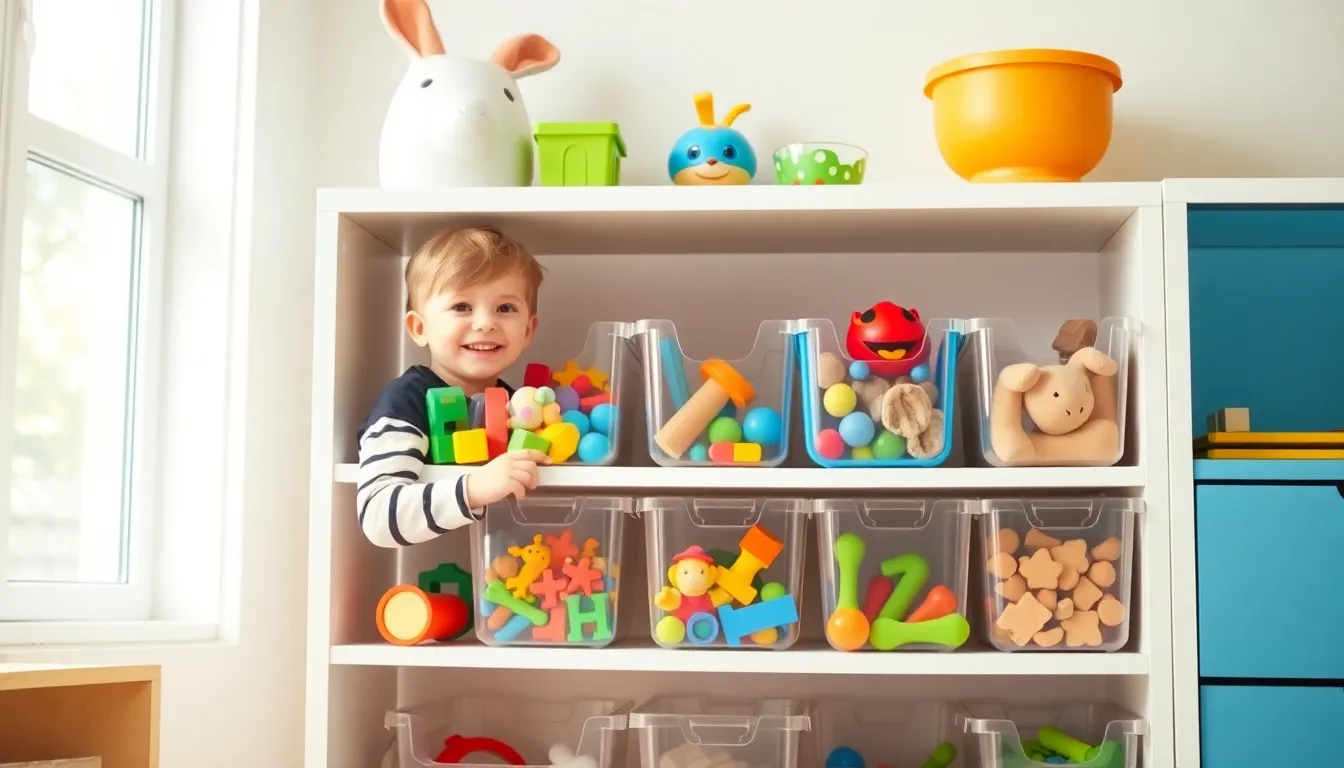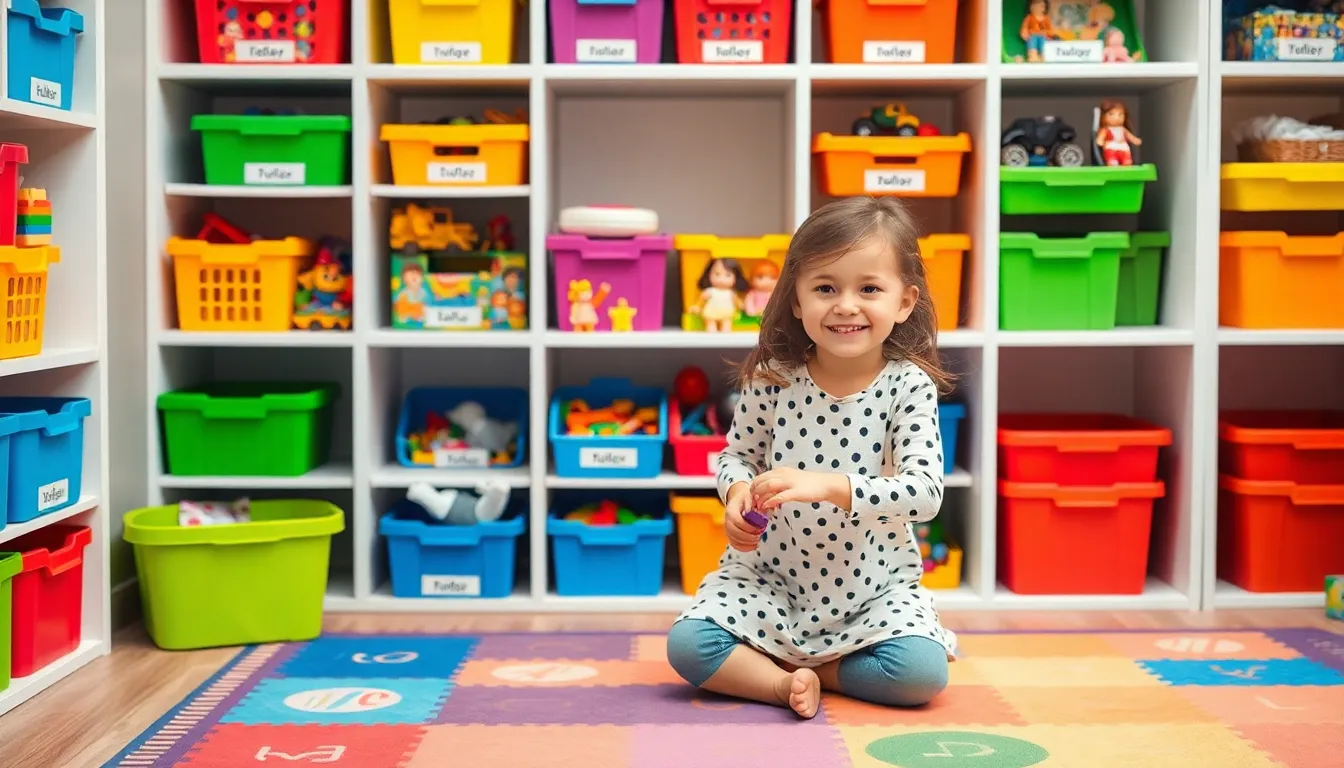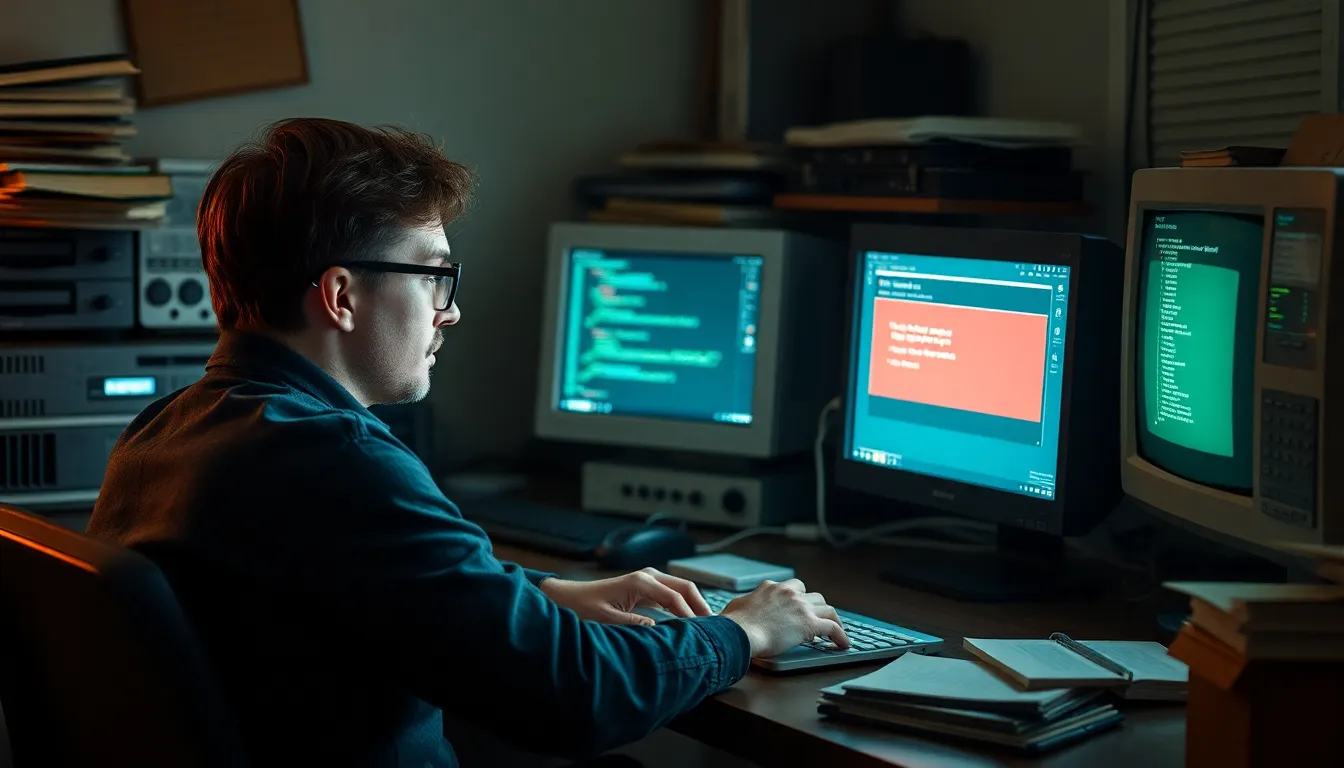Tired of stepping on rogue Lego pieces in the middle of the night? You’re not alone. Toy chaos can turn even the most serene playroom into a war zone. But fear not! With a sprinkle of creativity and a dash of organization, transforming that cluttered space into a haven of harmony is easier than it seems.
Table of Contents
ToggleCreative Toy Organizing Ideas
Utilizing bins and baskets promotes easy access to toys. Choose clear containers for visibility, making it simpler for kids to find what they want. Labeling these containers helps children understand where each item belongs. Use color coding to categorize different types of toys, such as blocks, dolls, and vehicles.
Incorporating shelving units maximizes vertical space. Opt for open shelves to display toys and encourage kids to keep them organized. Place frequently used items at lower levels for easy reach. Use decorative boxes on higher shelves for less accessible toys.
Employ a toy rotation strategy to reduce clutter. Store some toys away for a few weeks, then exchange them with others. This method keeps the play area fresh and engaging while minimizing mess.
Creating a play mat with built-in storage allows for easy cleanup. Foldable mats can double as a play area and a storage solution. When playtime ends, simply gather the toys into the mat’s pouch.
Repurposing furniture adds functionality to the space. Use an old dresser as a toy chest or a wooden crate as a bedside table for toy storage. These practical solutions save space and contribute to a coordinated room design.
Incorporating wall-mounted storage solutions enhances organization. Hanging organizers keep toys off the floor while adding visual interest. Magnetic strips can hold small metal toys, ensuring they remain easily accessible.
Utilizing a rolling cart offers flexible storage options. Carts can move from room to room, adapting to playtime needs. Fill them with art supplies, toys, or books, allowing for an organized yet mobile play area.
Benefits of Organizing Toys

Organizing toys offers multiple advantages that improve both the space and the play experience. Clutter-free environments foster creativity and focus, providing children with designated areas for play.
Reducing Clutter
Reducing clutter leads to a more manageable and efficient space. Organized toys occupy less visual space, allowing for easier navigation and play. Parents often notice that children spend more time engaging with toys when they aren’t overwhelmed by disarray. Using bins and clear containers not only helps in sorting toys but also in encouraging children to participate in clean-up routines. Streamlined organization prevents the build-up of unnecessary items, making room for new additions.
Enhancing Play Experience
Enhancing play experience stems from having accessible toys. When kids can easily find their favorite items, engagement and creativity flourish. Open shelves encourage independence, allowing children to take ownership of their play environment. Labeling storage helps reinforce learning and responsibility. Less time spent searching for toys translates to more meaningful playtime, fostering social skills and imaginative exploration. An organized space captivates children’s attention and stimulates their curiosity, leading to more enjoyable play experiences.
Types of Toy Storage Solutions
Toy storage solutions come in various forms, allowing for a tailored approach to organizing play areas. Implementing the right type can significantly enhance accessibility and aesthetics.
Bins and Baskets
Bins and baskets offer versatile storage options that suit different toy types. They come in numerous sizes and materials, making them adaptable for any space. Using clear bins helps visibility, allowing children to spot their toys quickly. Labeling each bin reinforces organization, assisting kids in returning toys to their designated places. Choosing colorful baskets can also add a decorative touch to the playroom while promoting a fun atmosphere. Stacking baskets maximizes space, and lightweight bins allow easy movement for children.
Shelving Units
Shelving units effectively utilize vertical space for toy storage. Open shelves encourage children to independently access and put away their toys. They come in various designs, from minimalist to themed, allowing parents to match the playroom’s decor. Organizing toys by category on shelves simplifies cleanup, enabling easy rotation among toys. Additionally, implementing adjustable shelves provides flexibility as children’s needs evolve over time. Conveniently placed lower shelves allow kids to reach their favorite toys, fostering a sense of ownership and responsibility.
Wall-Mounted Organizers
Wall-mounted organizers showcase toys beautifully while saving floor space. These solutions work well with small playrooms, maximizing available areas. Different styles, such as pockets or racks, cater to various toy types, including dolls and action figures. Utilizing wall space keeps toys off the ground, resulting in a neater appearance. Children can interact with their toys easily, promoting engagement. Implementing colorful wall organizers not only enhances organization but also serves as an attractive design element in the room.
DIY Toy Organizing Projects
Creating a harmonious play space becomes simpler with a few DIY organizing projects. These projects not only maximize storage but also add a personal touch to a child’s play area.
Upcycled Toy Storage
Upcycled materials offer innovative storage solutions for toys. Wooden crates can transform into stylish storage bins with a few coats of paint. Plastic containers, once destined for recycling, often serve as functional toy organizers when decorated and labeled. Wine racks can hold stuffed animals or books, turning into unique displays. Repurposing old furniture into storage units provides an effective way to declutter. Create a sensory bin from a large container, filling it with building blocks or other small toys. These upcycled options promote creativity, save money, and contribute to environmental sustainability.
Customized Labels
Customized labels empower children to take ownership of their play space. Brightly colored labels enhance visibility and make finding toys easier. Use simple words along with pictures to help younger children identify items quickly. Tie labels to bins and baskets with twine or adhesive, ensuring each storage solution remains organized. Magnetic labels offer the advantage of easy adjustment as toy collections change. Involvement in labeling allows children to practice reading and organization skills. Customized labeling adds an element of fun while fostering responsibility in maintaining an organized space.
Transforming a chaotic play area into an organized haven is achievable with the right strategies. By incorporating creative storage solutions and DIY projects parents can foster an environment that enhances children’s play experiences. Utilizing bins and baskets not only keeps toys accessible but also adds a decorative touch.
Implementing labeling systems and color coding encourages kids to take responsibility for their belongings. With these organizing ideas in place playtime becomes more engaging and less overwhelming. An organized space not only stimulates creativity but also promotes independence and responsibility in children. Embracing these toy organizing techniques can lead to a more harmonious household where play thrives.



